Disclaimer: machine translated by DeepL which may contain errors.
Special Article: Education at the Faculty of Science and Graduate School of Science in the Corona Disaster
 |
Introduction
|
 |
Department of Mathematics
Masahiro Yamamoto, Professor, Department of Mathematics
In the Department of Mathematics, lectures were generally given online. Needless to say, the Department of Mathematics curriculum has a low weighting of experiments and practical training, and most of the lectures are given in classrooms, but there are many essentials that can only be conveyed in face-to-face lectures, even in theory courses. For this reason, I would like to introduce the face-to-face lectures on Complex Analysis I and II given by Professor Kengo Hiraji. These lectures lasted for one year. The lectures were recorded by the video staff of the Graduate School of Mathematical Sciences and distributed on YouTube on the same day. Lecture notes were distributed, exercises were presented by students on the blackboard, corrected answers were delivered as images, and students who participated online were able to correct their answers by file. The students who attended the lecture seemed to enjoy meeting their classmates very much. The infection control measures were well taken, and as a result, there were no problems.
 |
|
| Complex Analysis exercise in a large lecture room at the Graduate School of Mathematical Sciences (a video camera was set up in the back of the room during the lecture). | |
The Department of Mathematics has originally been engaged in lectures, seminars, and video interviews of prominent visiting foreign researchers quite frequently for the purpose of building a video archive, and having a full-time video staff for this purpose has been a great help for the creation of lecture videos. In addition, computer exercises are conducted in an on-demand format rather than face-to-face, and we are preparing to make lecture videos and other materials available on the UTokyo OCW.
We believe that this kind of movement will be accelerated by the commercialization trend of recording and distributing lectures by world-famous universities, although we believe that it is not limited to mathematics.
Department of InformationScience
Kazumasa Sato, Associate Professor, Department of Information Science
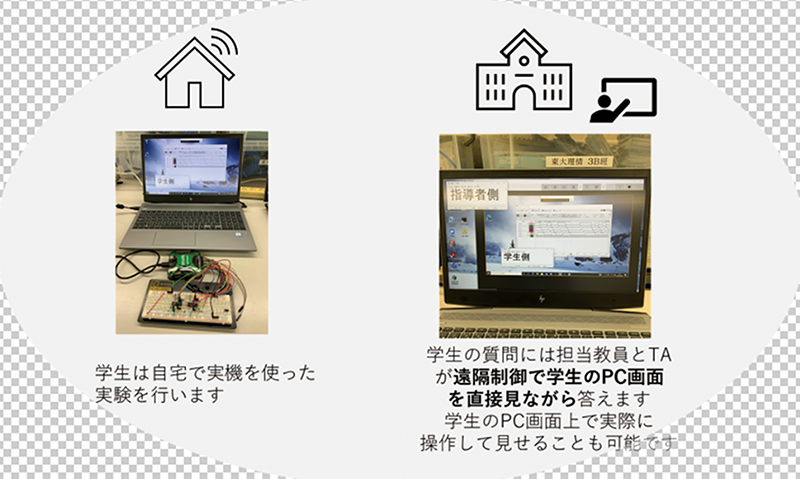 |
|
| Description of Hardware Experiment | |
The Department of Information Science has been devising various ways to hybridize online classes with face-to-face classes. Here are some examples.
In the "Data Structures and Algorithms" course, the faculty member in charge of the course developed the InkLecture software, an infinitely scrollable whiteboard suitable for online lectures, and realized an online class for writing on the board. The software enables handwriting input with a pen touch and infinite vertical scrolling, making it possible to virtually continue writing on the blackboard without erasing the blackboard. When a lecture is over and the program is closed, a copy of the board is saved on the desktop, so the board can be distributed to students as it is.
In addition to classroom lectures, hands-on experiments with computers are indispensable for education, and the "hardware experiments" in FY2020 were conducted completely online. In order to conduct the experiments, necessary equipment was newly prepared for each student and delivered to his/her home, and PCs distributed by the Department to each student were remotely controlled by the teacher and TAs, so that students could ask questions and evaluate the results with specific operations. The virtual classroom was also used to reproduce the situation in the face-to-face lecture as much as possible.
In the processor experiment (commonly known as the CPU experiment), one of the Department of Information Science's signature experiments, FPGA boards (devices that allow users to change the circuit configuration) for use in the experiment were distributed to each group so that they could develop their own CPUs at home. Weekly progress report meetings were held in a hybrid face-to-face and online format, using four lecture rooms, which is more than usual, in an effort to avoid density.
Department of Physics/ Department of Physics
Masao Ogata, Professor, Department of Phys ics
Lectures in the Department of Physics and Department of Physics are currently online because many students from other Departments and Departments of Physics attend the lectures every year and the lectures are given to a large number of people. We hope to resume face-to-face classes as soon as possible after the corona disaster subsides. In addition to lectures, "Physics Experiments I & II" and "Physics Seminar" for third-year Faculty students, and "Special Experiments I & II, Theory Exercises I & II (equivalent to graduation research)" for fourth-year Faculty students are conducted face-to-face with small numbers of students and with infection control measures in place.
 |
|
| Laboratory of "Electronics. The layout has been changed to prepare one set of experimental equipment for each student and to open the distance between desks. | |
For example, in Summer semester "Physics Experiment I," four themes (6-7 students per theme, about 3 days), one theme less than in previous years, were conducted in person. In consideration of the fact that some students traveled to the campus after attending online lectures at home, the start time of the experiments was moved back by one hour to 2:00 p.m. In addition, the time spent on campus was shortened by holding an experiment briefing session at the beginning of the academic year, conducting part of the experiment such as data analysis, and submitting reports and examinations online. When conducting experiments, we managed access to the campus using the University of Tokyo's health management system, and we encouraged basic infection control measures such as hand sanitization and ventilation. In the laboratory, experimental equipment and displays were expanded, and experiments and data processing, which are usually conducted in groups of two or three students, were conducted by each student individually to avoid "dense" situations. In Autumn semester "Physics Experiment II," each student will be assigned 4 themes (3-5 days for each theme) from 13 themes, and the experiments will be conducted under the same considerations.
In addition, multiple student waiting rooms have been set up so that students can participate in face-to-face experiments after attending online lectures on campus. We are operating these rooms with guidance so that students do not feel crowded in the large rooms.
Department of Astronomy / Department of Astronomy
Michiko Fujii, Associate Professor, Department of Astronomy / Tatsuki Sakon, Assistant Professor, Department of Astronomy
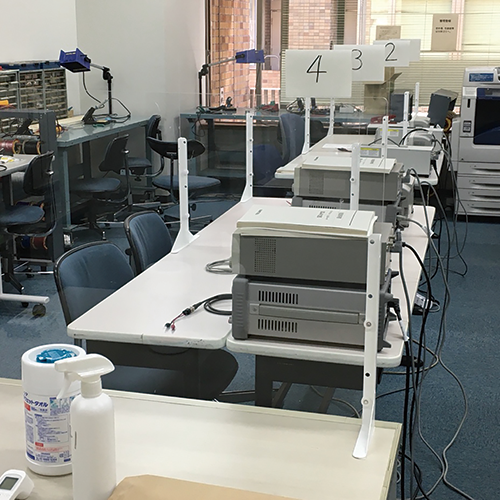 |
|
| Measurement equipment and laboratory 1041 for analog electronic circuit experiments in the basic astronomy experiment. | |
In basic astronomy experiments, we use equipment and measuring instruments that are only available at the university. Therefore, we designed the class format with the top priority of "never creating clusters" while complying with the action guidelines under a declared state of emergency and the university's action limit level. First, the course period was changed to year-round so that experiments could be conducted at times when the university's action limit level was B or lower. In terms of environmental improvement, one student laboratory was expanded to two. In addition, group practice was avoided, so that each student could reserve a room and laboratory equipment at a time of his/her choice, and the time of entry/exit and health conditions could be controlled retroactively. In addition, the equipment used was thoroughly disinfected. For optical experiments that require pairs of students to operate equipment, a small, simple darkroom has been set up in the room to conduct the experiments. In addition, we provided an opportunity for students to share their questions that could not be solved by themselves, to grasp inconveniences in the implementation, and to induce communication among students via Zoom once a week for about three months. As a result, the report submission rate was 100%, with some of the best reports in recent years. We would like to express our gratitude and respect to the students who agreed to the policy and worked hard in the unfavorable environment.
In addition, multiple student waiting rooms were set up so that students could participate in face-to-face experiments after listening to online lectures on campus. We are operating these rooms with guidance so that students do not feel crowded in the large rooms.
Note: The University's behavior restriction level B is the current standard; at that time, it was level 1.
Department of Chemistry /Department of Chemistry
Takemasa Ozawa, Professor, Department of Chemistry
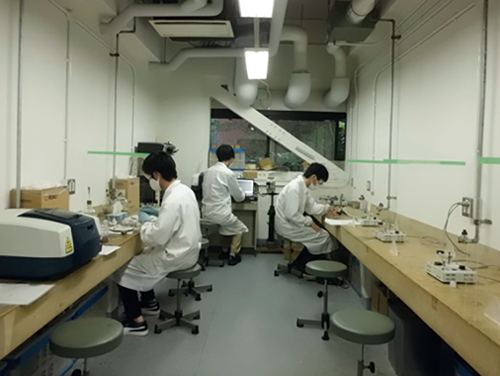 |
|
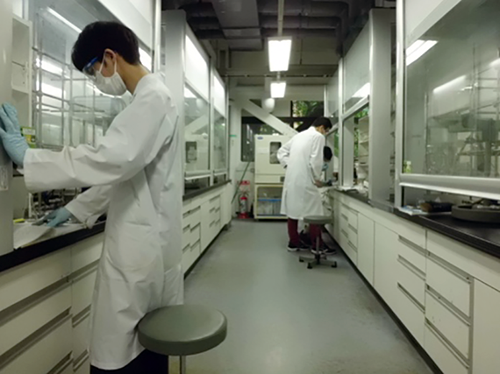 |
|
| Top: Measurement room partitioned by acrylic panels Bottom: Experiment in front of a table-top hood |
|
The Department of Chemistry offers lectures for third-year Faculty students and face-to-face student experiments. All afternoon hours (3rd and 4th periods) from Monday through Friday are all required laboratory practical training, with the aim of tackling the understanding of the properties and phenomena of matter head-on. In the practical training, students acquire the skills that form the basis of chemical experiments, and there are many units that cannot be covered in classroom lectures. Therefore, in principle, face-to-face practical training is conducted, and video materials are used as a backup to countermeasures against coronavirus infection. Specifically, in Summer semester, the number of students in the laboratory is about 2/3 of the total number of students, and the remaining 1/3 of the students watch videos of experiments and discuss and write reports in a separate room in order to avoid 3-density. Videos of student experiments are made for each unit and are being filmed for use as a backup in case a student becomes infected. In addition, measurements are made in parallel in a small room, and discussions between teachers and students are conducted using acrylic panels to provide sufficient ventilation to prevent droplet infection. In addition to white coats and safety glasses, students are required to wear masks and gloves at all times during experiments. Morning lectures for third-year undergraduate students are held in a large lecture room in the east wing of the Faculty of Science Building No. 1 to ensure sufficient space between students, and the windows and doors are open to provide adequate ventilation for face-to-face lectures. In addition, a new system for hybrid lectures has been installed in a lecture room on the third floor of the Chemistry Main Bldg. Students can view the board and the screen together with the images of the lecturer as if they were in the lecture room online. In the future, we plan to make active use of the hybrid lecture rooms.
Department of Earth and Planetary Physics / Department of Earthand Planetary Environmental Science
Seiji Sugita (Professor, Department of Earth and Planetary Physics / Department of Earth and Planetary Environmental Science)
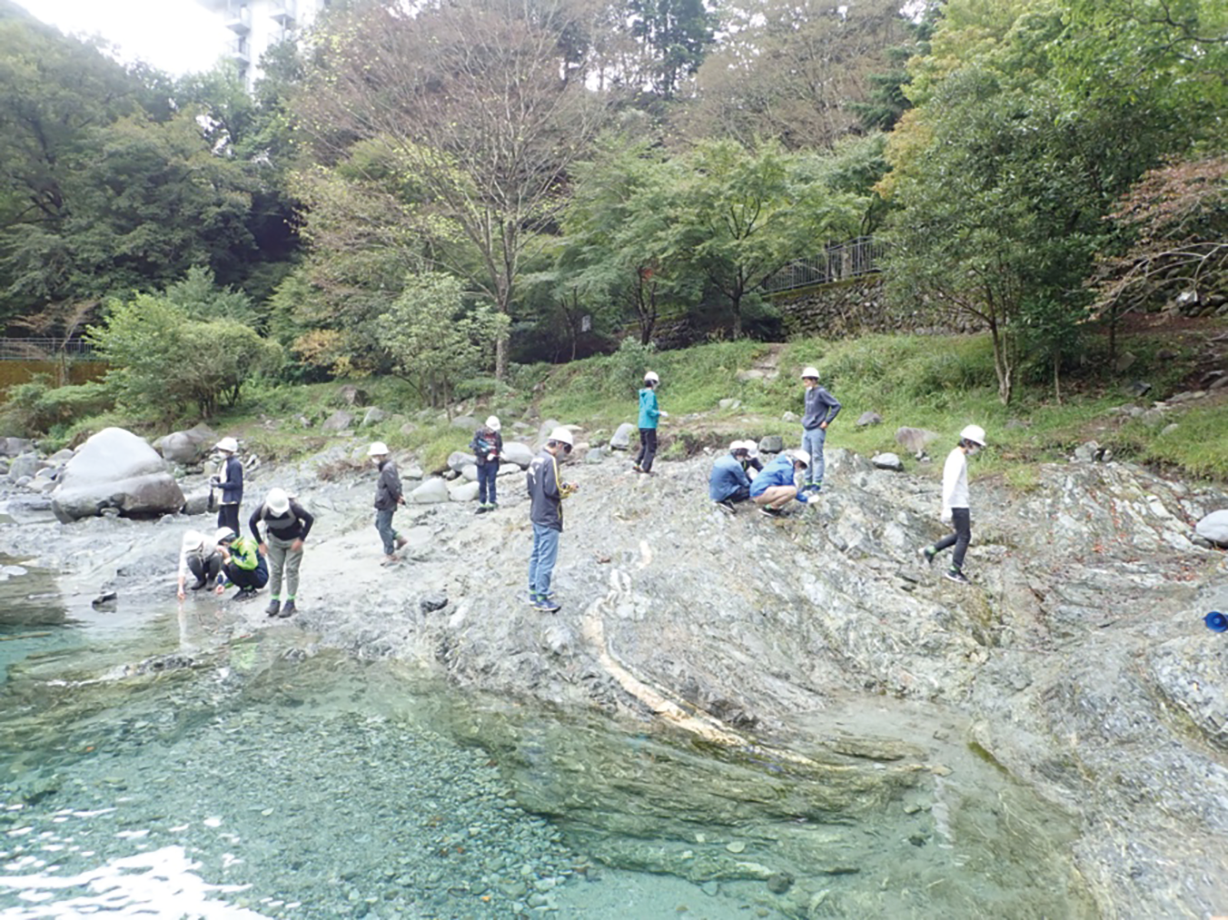 |
|
| Students conducting a field survey in Tanzawa. The survey was supported by donations from alumni. | |
Since education in these two Departments and one Department are conducted in the same building and share some common courses, the three departments worked together to provide a unified response to the coronal disaster. While lectures were given online, field training was conducted in person while taking measures to prevent infection, since outdoor investigation and observation are essential for education. Experiments, practical training (including computer exercises), and theoretical exercises were conducted in a mix of face-to-face, hybrid, and online, taking into consideration the infection situation and course content, as described below.
![]() Department of Earth and Planetary Environmental Physics: Last year, the computer lab was immediately set up with a virtual machine environment, and the entire course was conducted online with minimal delays. This year, a hybrid format was used where students who wished to attend were allowed to do so up to 1/3 of the capacity of the computer lab. Theoretical exercises were conducted online last year, and this year we used both face-to-face and online formats with students who wanted to attend the large classroom. In the laboratory classes, online and face-to-face sessions were used according to the experimental tasks, and video teaching materials were created to improve the educational effect.
Department of Earth and Planetary Environmental Physics: Last year, the computer lab was immediately set up with a virtual machine environment, and the entire course was conducted online with minimal delays. This year, a hybrid format was used where students who wished to attend were allowed to do so up to 1/3 of the capacity of the computer lab. Theoretical exercises were conducted online last year, and this year we used both face-to-face and online formats with students who wanted to attend the large classroom. In the laboratory classes, online and face-to-face sessions were used according to the experimental tasks, and video teaching materials were created to improve the educational effect.
![]() Department of Earth and Planetary Environmental Science: Indoor laboratory classes were conducted in a face-to-face format with the equipment moved to the large lecture room and the space between the classes taken up by the students. In the last fiscal year, the face-to-face training was started earlier than any other department in the Faculty of Science. In addition, we were able to complete all domestic field training courses, although some of them were scaled down. This year, all fieldwork was started in a face-to-face format without delay. No overseas field survey was conducted, but alternative domestic surveys are being considered.
Department of Earth and Planetary Environmental Science: Indoor laboratory classes were conducted in a face-to-face format with the equipment moved to the large lecture room and the space between the classes taken up by the students. In the last fiscal year, the face-to-face training was started earlier than any other department in the Faculty of Science. In addition, we were able to complete all domestic field training courses, although some of them were scaled down. This year, all fieldwork was started in a face-to-face format without delay. No overseas field survey was conducted, but alternative domestic surveys are being considered.
![]() Department of Earth and Planetary Science: Research for the dissertation was conducted by academic supervisors using an appropriate combination of online and face-to-face sessions, while using a time-rate of entry to the campus to prevent the close proximity of graduate student rooms and laboratories.
Department of Earth and Planetary Science: Research for the dissertation was conducted by academic supervisors using an appropriate combination of online and face-to-face sessions, while using a time-rate of entry to the campus to prevent the close proximity of graduate student rooms and laboratories.
Department of Biophysics and Biochemistry / Department of Biological Sciences
Hirofumi Kunitomo (Associate Professor, Department of Biophysics and Biochemistry) / Haruhiko Taneida (Associate Professor, Department of Biology) / Kumiko Cheng (Associate Professor, Department of Bioinformatics and Systems Biology )
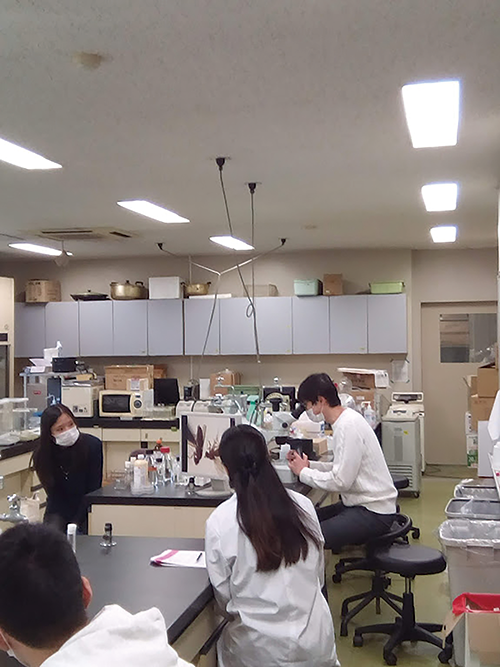 |
|
| A scene from the practical training for graphic arts students. Experimental operations under a microscope are transmitted to a monitor for observation from a remote location. Observation from a distance via a monitor |
|
In addition to lectures incorporating the latest findings, practical training and experiments involving live experimental materials are essential for learning and research in the life sciences. Most of the lectures in each Department and Division are conducted online. On the other hand, student practical training, which requires biological samples and laboratory equipment, is conducted in person to increase the effectiveness of education and to encourage interaction among students. In addition to wearing masks and taking temperatures, infection prevention measures are taken, such as dividing students into two groups and conducting experiments in parallel to avoid close contact (separate laboratories are provided), or conducting experiments in shifts. In units where it was necessary to shorten the time required for practical training, the experimental procedures and content were streamlined. Unavoidable waiting time is used for explanations and assignments related to the practical training. The Department of Biophysics and Systems Biochemistry and Department of Information Science jointly conduct the Summer semester student training, but students can choose to take the information analysis part in the laboratory or at home. The Department of Biology's field training, which requires students to go outside the campus, is conducted with measures such as antigen screening for all participants, accommodation in one room per person in principle, and strict prohibition of private conversation during meals, so that students do not lose the opportunity to come into direct contact with animals and plants. On the other hand, the Department of Information Science in the second semester of the third year is conducting online practical training as usual, and the lecture rooms in the Faculty of Science Building No. 2 and No. 3, which are mainly used by the three Departments of Science and Systems Biology, are open to students so that they can take online classes and exercises. In addition, gloves and masks have been worn in the laboratories on occasion, and are now the norm. In addition, the department takes every possible measure to prevent infection, such as disinfecting the eyepieces of microscopes each time they are used.
With the cooperation of the Faculty of Science's Academic Affairs Committee, this project is designed to introduce the reality of the education at the School of Science and Graduate School of Science at the Corona Disaster. We hope that it will serve as an opportunity to make the current educational and research environment of the Faculty of Science widely known to the public and to inform students who are aiming to study at the Faculty (Communications & Public Relations Committee).


